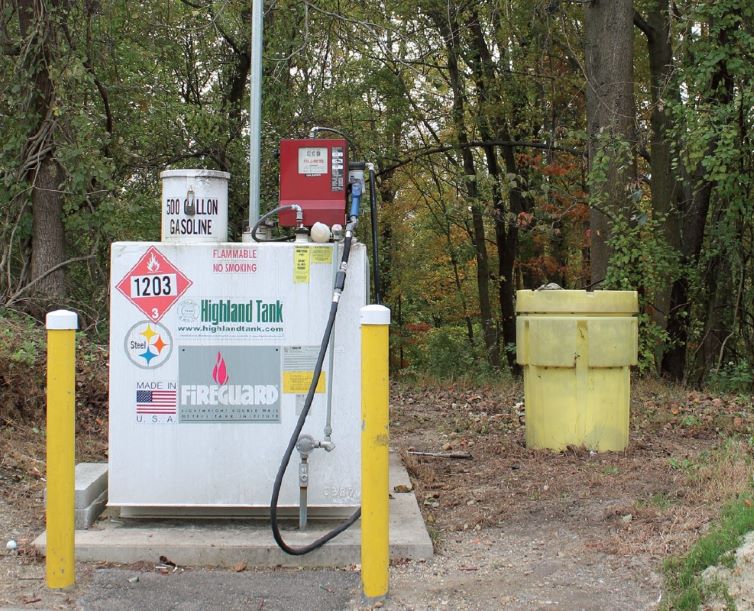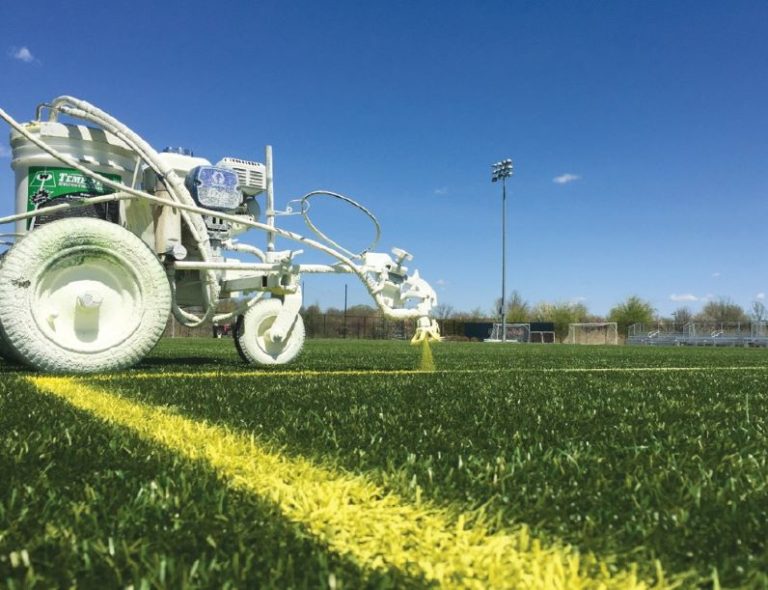The following maintenance operations best management practices are excerpted from SFMA’s National BMP guide, Best Management Practices for the Sports Field Manager: A Professional Guide for Sports Field Management. The full guide, as well as a customizable BMP template, is available at https://www.sportsfieldmanagement.org/knowledge_center/bmps/
Storage facilities
Well designed, maintained and ventilated storage facilities protect human health and environmental quality. Storage areas should be secure and provide containment features. Such facilities protect personnel from exposure to chemicals, protect chemicals from extreme temperatures and excess moisture and reduce liability concerns and potential environmental risk. In addition, having a climate-controlled storage facility can prevent some storage issues. For example, some dry fertilizers can be prone to caking in non-climate-controlled storage.
Any leaks and spills of chemicals in the storage area must be responded to promptly and adequately to prevent a release that extends beyond the storage area, using the same methods and equipment as described in the Emergency Preparedness chapter of SFMA’s National BMP guide. Local Extension offices can be consulted for detailed information on regulatory requirements and guidance on storage facilities.
Safety Data Sheets for all chemicals stored in a storage facility should be always readily available to employees, employers, and any emergency personnel. Safety Data Sheets provide important information on hazardous chemicals, including PPE requirements.
Equipment storage and maintenance
Equipment storage and maintenance facilities should be designed to prevent the accidental discharge of chemicals, fuels or contaminated washwater from reaching water sources. Properly storing and maintaining equipment also extends the useful life of machines and reduces repairs.
Equipment cleaning
Equipment cleaning guidelines and restrictions should be established that reduce the potential for pollutants to reach surface water or groundwater. Proper cleaning of equipment helps prevent residues (grass clippings, soil, soap, oil, fertilizer and pesticide) from reaching surface waters, groundwater, drainage pipes, or storm sewers.
If possible, equipment cleaning should be conducted under controlled conditions in an appropriate contained area.
The nitrogen and phosphorus nutrients in grass clippings can increase the nutrient loading to surface waters through washwater drainage. Using compressed air or a leaf blower to blow clippings off mowers before washing can help reduce the amount of nutrients that enters drains via washwater.
The use of high-powered air is also recommended for those areas of the machine that water should not be used. Always follow manufacturer’s recommended cleaning processes.
The best practice is to have a dedicated cleaning area with a catch basin to collect remaining grass clippings. Clippings can be collected, then composted or removed to a designated debris area. When formal cleaning areas are not available, using a short, portable hose to wash off the grass at random locations, away from surface waters, wells or storm drains is an option.
For equipment with possible pesticide residue, BMPs should be followed to ensure that washwater does not become a pollution source. Captured washwater can be used as a dilute pesticide per label, or it may be pumped into a rinsate storage tank for use in the next application and used as a dilute pesticide per the label.
Paints
Best management practices related to the handling and storage of paint used on sports fields with respect to protecting environmental quality prevent paint and paint residue from becoming a water quality contaminant and reduce the amount of paint wasted.
Paint selection
Water-based paints adhere to turfgrass without impeding photosynthesis and therefore are the preferred choice for natural grass fields. Chalk, typically limestone or marble, builds up over time and slows down water movement into the soil. Chalk should only be used on the skinned infield surfaces of baseball or softball diamonds, applied lightly and dragged into the base infield material after games or removed with a shovel. Chalk can be avoided altogether by spray painting baselines and batter’s boxes. For paint to adhere cleanly to soil or clay, the ground must first be wetted down.
When using turfgrass paints, two ingredients in the paint are of importance: titanium oxide (pigment) and calcium carbonate (filler). Paints containing low amounts of titanium oxide typically contain higher concentrations of calcium carbonate (CaCO2); colored paints typically have the highest concentrations of CaCO2. If applied frequently enough in the same area, CaCO2 can harden the soil and weaken the turfgrass.
Paint mixing and cleaning
To prevent any paint or paint residue from reaching surface waters, paint should be prevented from reaching a storm drain or any other kind of drain that does not go to a water treatment facility. Try to always mix and clean paint machines over a water recycling station or a sanitary sewer inlet. Any time paint is handled or stored, or paint equipment cleaned, the paint should be prevented from getting into a storm drain or any other kind of drain that does not go to water treatment facility.
Paint management and storage
The paint inventory should be managed to avoid having paint stored for an extended period. This will help lessen the potential for waste; fresh paint also performs better for field marking. When stored, paint should not be exposed to extreme heat or freezing cold. If possible, paint should be stored inside. If stored outside, it should be covered with a tarp.
Fueling facilities
Designated fueling areas should be sited on impervious surfaces and located away from surface waters and water wells. Catch basins in fueling areas should be directed toward an oil/water separator or sump to prevent petroleum from moving outside any containment structure. Floor drains in fueling areas should be eliminated unless they drain to containment pits or storage tanks.
Various fuel storage methods may be employed by different-sized facilities. Newer facilities may utilize aboveground storage tanks (AST) to store fuel. ASTs are easy to monitor for leaks and are a preferred storage method. Older facilities may utilize underground storage tanks (UST). Because of the potential for groundwater contamination from leaking USTs, leak detection monitoring is a critical aspect of UST compliance. Finally, smaller facilities often use gas cans to store fuel. These fuel cans must be properly labeled. The containment methods must be adequate in case of any spill or leak. A spill kit or a bucket of “oil dry” should be in the immediate vicinity. Any leaks or spills must be contained and cleaned immediately.

Waste handling
Facilities need to regularly review how they handle the disposal of unwanted, expired or accumulated items, including chemicals, paints, pesticides, tires, batteries, used oils, solvents, paper products, plastic or glass containers and aluminum cans. Developing recycling programs reduces waste and minimizes the quantity of waste reaching landfills. In some cases, recycling of some wastes may be required locally, and sports field managers should be aware of these requirements.
All packaging from chemicals, their containers, and other wastes should be properly disposed of. Pesticide-specific waste handling requirements are identified on the pesticide label and are discussed in more detail in the Pesticide Management chapter of SFMA’s National BMP guide.
For the full article, including BMP checklists, see the December issue of SportsField Management magazine.


